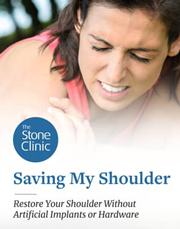Mumford Procedure Rehab Protocol
- Do not elevate surgical arm above 70° in any plane for the first 4 weeks post-op
- Do not lift any objects over 5 pounds with the surgical arm for the first 6 weeks
- Avoid excessive reaching and external/internal rotation for the first 6 weeks
- Ice shoulder 3 - 5 times (15 minutes each time) per day to control swelling and inflammation
- An arm sling is used for 4 weeks post-op
- Maintain good upright shoulder girdle posture at all times and especially during sling use
- MD follow-up visits at Day 1, Day 14 with nurse for suture removal, Month 1, Month 3, and Year 1 Post-op
Week 1:
- MD visit Day 1 post-op to change dressing and review home program
- Postural education
- Exercises (3 times per day):
- Pendulum exercises
- Squeeze ball
- Triceps and biceps training with Theraband
- Isometric rotator cuff external and internal rotations with arm at side
- Isometric shoulder abduction, adduction, extension and flexion with arm at side
Weeks 2 – 4:
- Clinic visit at 14 days post-op for suture removal and check-up
- Use of strapping tape for secondary AC compression and support (optional)
- Soft tissue treatment for associated shoulder and neck musculature for comfort
- PNF for elbow and wrist flexion and extension, scapular isometrics with manual resistance
- Add well-body exercises, maintaining protection of AC joint (i.e. squats, lunges, step-ups, bridging, opposite arm rotator cuff exercises, biking)
Weeks 4 – 8:
- MD visit at Week 4 post-op and will usually be progressed to a more aggressive ROM and strength program
- At Week 4: Start mid-range of motion (ROM) rotator cuff external and internal rotations active and light resistance exercises (through 75% of ROM as patient’s symptoms permit) without shoulder elevation and avoiding extreme end ROM
- Strive for progressive gains to 90º of shoulder flexion and abduction
Weeks 8 – 12:
- Seek gentle full shoulder ROM in all planes--especially with flexion, abduction, external rotation and internal rotation
- Increase manual mobilizations of soft tissue as well as glenohumeral and scapulothoracic joints for ROM
- Exercises: Wand exercises, ROM shoulder pulleys, scapular training (rows, protractions, lower trapezius work, etc), PNF
- No overhead lifting
Week 12 and beyond:
- Start a more aggressive rotator cuff program as tolerated
- Start progressive resistance exercises with weights as tolerated
- Continue to seek full shoulder range of motion in all planes
- Increase the intensity of strength and functional training for gradual return to activities and sports
- Return to specific sports is determined by the physical therapist through functional testing specific to the sport
NOTE: All progressions are approximations and should be used as a guideline only. Progression will be based on individual patient presentation, which is assessed throughout the treatment process.
Don't Know Why Your Shoulder Hurts? Use our Shoulder Pain Symptom Checker to learn more about your symptoms and possible injury conditions.
